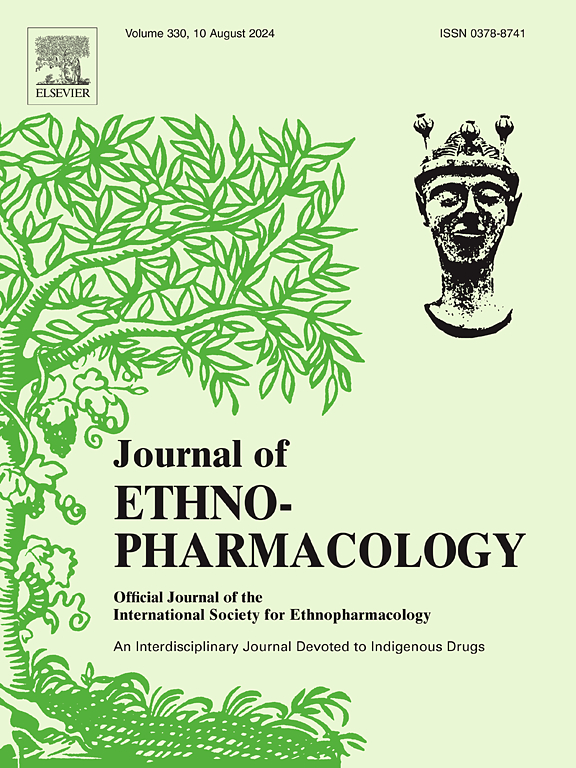Ethanol precipitation process affects the pharmacokinetic characteristics of major active glycosides of Qiong-Yu-Gao: evidences in normal and cisplatin-induced acute kidney injury rats
IF 4.8
2区 医学
Q1 CHEMISTRY, MEDICINAL
引用次数: 0
Abstract
Ethnopharmacological relevance
Qiong-Yu-Gao (QYG) is a classical formula that shows protective effects against cisplatin-induced acute kidney injury (AKI). Recent evidence indicates that iridoid glycosides and ginsenosides are the main active substances of QYG. In the production of modern Chinese medicine preparations, ethanol precipitation is a commonly applied but not fully verified refining process.
Aim of study
Pharmacokinetic profiling approaches were used for evaluating the rationality of ethanol precipitation process in the production of modern QYG preparations.
Materials and methods
Ethanol precipitation was used to prepare the glycoside-rich fraction (QYG-GS). UPLC-TQ-MS/MS methods were established for quantification of iridoid glycosides and ginsenosides of QYG in plasma and fecal samples. The pharmacokinetic profiles of major glycosides were characterized and compared after oral administration of QYG and QYG-GS in both normal and cisplatin-induced AKI rats.
Results
Using the validated quantitative methods, 6 glycosides were determined in plasma samples, and 14 glycosides were determined in fecal samples. More significant pharmacokinetic differences were observed in AKI rats than in normal rats. The ethanol precipitation process significantly increased the Cmax and AUC0-t of catalpol, rehmannioside D, melittoside, leonuride and ginsenoside Rb1, and decreased the T1/2 and MRT0-t values, indicating the increased absorption and accelerated elimination. Additionally, ethanol precipitation significantly decreased the fecal contents of above compounds, but increased the fecal contents of compound K.
Conclusions
UPLC-TQ-MS methods were developed and validated for quantification and comparison of QYG glycosides in biological samples. The ethanol precipitation process significantly altered the pharmacokinetic profiles of major active glycosides in QYG, especially in AKI rats. The findings could provide a helpful reference for selection of ethanol precipitation process in the production of modern QYG preparations.

乙醇沉淀过程影响琼玉膏主要活性苷在正常及顺铂急性肾损伤大鼠体内的药动学特征
民族药理学意义琼瑶高(QYG)是一个经典方剂,对顺铂诱导的急性肾损伤(AKI)具有保护作用。最近的证据表明,鸢尾甙和人参皂苷是琼瑶浆的主要活性物质。材料与方法采用乙醇沉淀法制备富含苷元的琼瑶浆制剂(琼瑶浆-GS)。建立了血浆和粪便样品中 QYG 的鸢尾甙和人参皂苷的 UPLC-TQ-MS/MS 定量方法。结果采用已验证的定量方法,在正常大鼠和顺铂诱导的 AKI 大鼠口服 QYG 和 QYG-GS 后,分别测定了血浆样本中的 6 种苷类化合物和粪便样本中的 14 种苷类化合物。与正常大鼠相比,AKI 大鼠的药代动力学差异更为明显。乙醇沉淀过程明显增加了梓醇、地黄甙 D、美利曲塞、利血平和人参皂苷 Rb1 的 Cmax 和 AUC0-t,降低了 T1/2 和 MRT0-t 值,表明吸收增加,消除加快。此外,乙醇沉淀显著降低了上述化合物的粪便含量,但增加了化合物 K 的粪便含量。乙醇沉淀过程明显改变了 QYG 中主要活性苷类的药代动力学特征,尤其是在 AKI 大鼠体内。研究结果可为现代逍遥丸制剂生产中乙醇沉淀工艺的选择提供有益的参考。
本文章由计算机程序翻译,如有差异,请以英文原文为准。
求助全文
约1分钟内获得全文
求助全文
来源期刊

Journal of ethnopharmacology
医学-全科医学与补充医学
CiteScore
10.30
自引率
5.60%
发文量
967
审稿时长
77 days
期刊介绍:
The Journal of Ethnopharmacology is dedicated to the exchange of information and understandings about people''s use of plants, fungi, animals, microorganisms and minerals and their biological and pharmacological effects based on the principles established through international conventions. Early people confronted with illness and disease, discovered a wealth of useful therapeutic agents in the plant and animal kingdoms. The empirical knowledge of these medicinal substances and their toxic potential was passed on by oral tradition and sometimes recorded in herbals and other texts on materia medica. Many valuable drugs of today (e.g., atropine, ephedrine, tubocurarine, digoxin, reserpine) came into use through the study of indigenous remedies. Chemists continue to use plant-derived drugs (e.g., morphine, taxol, physostigmine, quinidine, emetine) as prototypes in their attempts to develop more effective and less toxic medicinals.
 求助内容:
求助内容: 应助结果提醒方式:
应助结果提醒方式:


